#multi-ungulate
Explore tagged Tumblr posts
Text

Southern greater kudu Tragelaphus strepsiceros strepsiceros, front
Common impala Aepyceros melampus, back right
Observed by swgarnett, CC BY-NC
#Tragelaphus strepsiceros strepsiceros#southern greater kudu#Aepyceros melampus#common impala#Bovidae#antelope#Africa#Botswana#multi-ungulate
125 notes
·
View notes
Text
One potential resolution for the "dragons couldn't evolve from vertebrates because they have six limbs" thing
I'm thinking bird-descended dragons (wyverns?) who underwent a similar process to ungulates turning cancer into antlers, but for "front legs." Develop these rigid growths that enable horizontal stability as their bodies get longer and lower. Gradually they gain some muscular control of the legs, though they'll never be as multi-jointed as real bone limbs. Like many theropods, dragons don't need those front limbs for a whole lot, so it works for them.
Maybe these growths spread all over the body. That could account for all the extra horns and frills and even re-evolved teeth (I'm thinking serrated keratin pseudoteeth as those jagged bits you see on the "lips" of dragons). A reinvention of pangolin armor from a whole new angle.
#I like that this hampers their ability to develop fine finger dexterity#Always a fan of tradeoffs#Even if they have personhood-level intelligence#There's no limb that can really manipulate things with precision#Especially if they are Lorge#Which is a built in reason to form symbiotic partnerships with little naked apes#worldbuilding#speculative evolution#spec evo#birds#dragons#wyverns
129 notes
·
View notes
Note
I hope I'm not asking too many questions... but I really love the skywhale trope and wanted to hear your thoughts on them?
i think we need more variety of whales in the sky! seems like more people go for a blue whale or humpback whale design on their sky whales, which is fine because they are very iconic whales and i love the way they look. but how about some beaked or toothed whales? flying orcas? a bowhead? i think a sky whale that looked like a bowhead whale would be just wonderful, look at this thing.


(image description: first is an underwater photo of a bowhead whale's face. the top of its mouth is very narrow while the bottom of it is enormous, like a pelican. there is a white patch at the front of its lower jaw with black spots in a line across it. the second image is a detailed illustration of the whale's whole body, comparing it to the size of an elephant and showing the shape of its fins and tail. the elephant is roughly the size of the whale's lower jaw. end description.)
i love this thing. look at that face. the humpback whale may have longer and prettier fins for that sky whale aesthetic, but the bowhead's face shape is delightful. more diversity in sky whale designs!
but of course, the more interesting thought is how exactly to make such an enormous vertebrate work as a flying animal. where is it going? what does it eat? what happens when it dies?
it would be more realistic for sky whales to be smaller, but when people think of sky whales, they want the huge size! it's a fantasy, we want the epic huge flying creatures with their strange singing calls swimming through the clouds. so i'm not going to talk about the more logical small flying whales that go around in flocks to hunt birds (though the idea of smaller flying dolphins is also delightful!) I'm going to just talk about big slow baleen sky whales, the most iconic and desired of all sky whales.
step one: how the heck are these things in the air. it's easier to explain how a dragon can fly, they have big powerful wings. how do whales fly? I think the clearest answer is that they have some form of massive internal air sac full of lifting gas. real life oceanic whales are full of blubber, but maybe sky whales don't have as much blubber and get a lot of their size from their big air sacs instead.
lifting gas is just an umbrella term for any gases that are lighter than the standard atmospheric air. this includes heated atmospheric air, hydrogen, helium, coal gas, ammonia, and methane. (according to wikipedia) and with that list I think we've found our answer. whales are actually even-toed ungulates like cows. they could easily produce a lot of methane with the right diet. they'd just keep it in their air sacs instead of releasing it as a waste material! and for the best production of methane, these sky whales should have multi-chambered stomachs.
This does mean they're probably going to eat a lot of plant matter! so imagine them swooping low to take huge mouthfuls of tree tops! terrifying! maybe their baleen is structured to scrape the leaves off the branches. Maybe they swoop down to kelp forests in the ocean and take huge mouthfuls of that as well. any critters they happen to consume in the process are just bonus snacks full of protein. they likely also consume large flocks of small birds on the go, and probably clouds of flying insects too! locust swarms, for example. watch out for the low flying whales! I think they'd be slow like blimps and mostly use their tails and fins to steer and swoop down for food. they probably also rub themselves on tree branches or mountain sides to scratch their itches. I bet they'd have a symbiosis with many bird species that pick off their parasites.
like cow manure, sky whale dung could be a great source of fertilizer. best to avoid the usual paths of migrating sky whales so you don't end up dead by having giant poop clumps fall on you, but once it's hit the ground, that's free whale manure for every farmer in the area. the lands along the paths of migrating sky whales are probably very fertile, which also serves the whales, since they'll be eating the leafy tree tops! and when a whale dies, falling to the ground, the resulting small earthquake would certainly be startling, and both the impact and the rot process would cause a lot of damage to the surrounding land.
things are not immediately fertilized when a corpse rots. it takes a while! the rot causes more harm at first and then starts to nourish the ground later.
and dead bodies tend to bloat with gases and i have already established that these whales are full of methane. a lot of it would be released at death anyway, and i don't think the whale would drop immediately. or perhaps they fly lower in their old age and just crash land and die slowly. either way, these things are huge and full of methane and then they bloat. which means they might also explode spontaneously as part of the decay process. the air for miles around is going to be so nasty. but i think if you live in sky whale territory, you're just going to have to get used to the stink, because the manure that falls on a more regular basis is also going to be so so stinky.
like real world whale falls, sky whale falls will attract absolutely every carnivorous creature in the area. anything that eats meat will follow that awful stench right to the source and start gnawing away at the thick skin. people will have the easiest time, since they have tools for this beyond just their teeth and claws. the faster the whale is cut open, the less likely there will be an explosive bloat stage, so I'm sure the culture of the region would have some superstitions about leaving a dead whale lying too long. if you don't go harvest that bounty, it will explode and you never know where those chunks will land.
and then when there's only bones, people use em for building all sorts of things! the societies that exist in the paths of sky whales would be very cool to see.
that turned into a ramble and I haven't even designed a sky whale lol. lemme doodle one real quick.

(image description: a sketch of a sky whale, which resembles the aforementioned bow whale, swooping down to munch on trees in a forest. end description.)
140 notes
·
View notes
Text
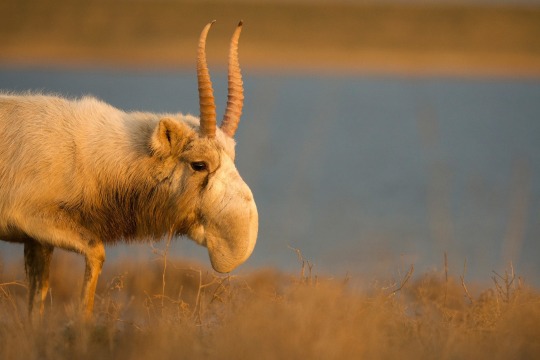
A Male Saiga Antelope in Russia's Black Land National Park. These highly social antelope live in herds. Photograph By Valeriy Malee/Nature Picture Library
This Floppy-Nosed Antelope Was Nearly Gone. 20 Years Later, It’s Thriving.
Less than a decade ago, more than half of the world’s saiga antelope were lost to a mysterious disease. Its comeback is a rare and phenomenal conservation success.
— By Jason Bittel | December 14, 2023
Just two decades ago, it seemed as if we might need to write a eulogy for the saiga antelope.
Cut down by widespread poaching and waves of disease, by 2003, just 6 percent of the floppy-nosed ungulates remained in Kazakhstan, Mongolia, Russia, and Uzbekistan.
But today, scientists are rejoicing at the saiga’s unlikely rebound.
There are now 1.9 million saiga antelope across Eurasia, according to the most recent estimates released this week. So many saiga, in fact, that the International Union for Conservation of Nature is upgrading the Red List status for the species from critically endangered to near threatened.
“There's a lot of conservation doom and gloom, and there isn't very much attention paid to conservation successes,” says E.J. Milner-Gulland, a conservation scientist at the University of Oxford and co-founder of the U.K-based Saiga Conservation Alliance. “It’s quite a vindication of 20 years of hard work by lots of people.”
To get a sense of just how far this species has come, in 2015, more than half of the worldwide population of saiga antelope were lost to a mysterious blood disease.
“This is phenomenal news,” says Joel Berger, an ecologist at Colorado State University and a senior scientist at the Wildlife Conservation Society, in an email.
“At a time when so many species and populations are in deep swan dives, to witness the recovery of saiga—a species deserving of more recognition in its own right—is something we all need to celebrate,” he says.
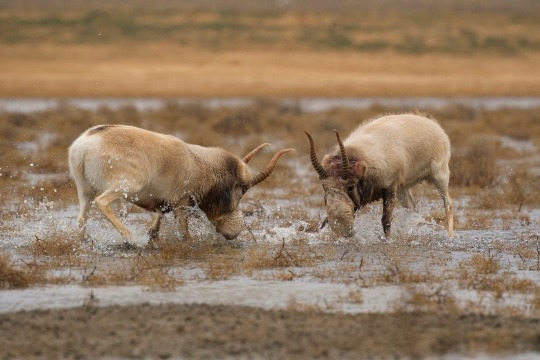
Male Saiga Antelope Battle in Black Lands National Park. Males and their horns are a specific target of poachers. Photograph By Valeriy Malee/Nature Picture Library
The Saiga’s Downward Spiral
Those who have been paying attention to the saiga’s saga know that it’s been a wild ride.
“Twenty years ago, it had the fastest increase in threat status of any mammal,” says Milner-Gulland. “The population had plummeted by more than 90 percent over a really short time of a few years, so it went straight in at critically endangered.”
As for what happened, Milner-Gulland explains that the saiga’s downfall can be attributed to several factors. For starters, saiga horn has great value in China, Singapore, Vietnam, and Malaysia as a component in traditional medicine. And this demand, coupled with the breakup of the Soviet Union, led to a dramatic rise in hunting.
It’s a Symbol of the Wild Steppe, of Independence and Freedom.
— E.J. Milner-Gulland, Conservation Scientist at the University of Oxford
“The economies of these countries basically collapsed,” she says. “And they were living in very harsh conditions on the steppe. So they turned to poaching.”
Fencing along the border between Kazakhstan and Uzbekistan also put a barrier in the middle of the saiga’s migratory route, while infrastructure development cut into saiga habitat. Finally, an unknown trigger turned a naturally occurring microbe in the saiga’s characteristic nose into a virulent pathogen, leading to the mass die-offs.
It’s for all these reasons that the IUCN has chosen not to de-list the saiga completely.
“The near threatened category is right for the saiga, because we know that at any time, we could just get large numbers of them dropping dead again,” says Milner-Gulland. “They are very vulnerable.”
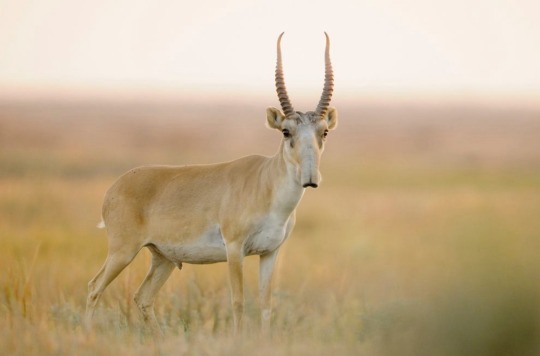
A Path to Recovery
Just as the threats to the saiga were multi-faceted, so too have been the efforts to protect the species, which are important seed dispersers and grazers that contribute to plant biodiversity.
For instance, an international collaboration between countries where saigas roam, countries that traditionally consume saiga products, and other stakeholder nations, including the United States, led to a memorandum of understanding in 2006 to conserve the species, restore its habitat, and restrict harvest to a sustainable level.
For its part, Kazakhstan’s government focused on stronger anti-poaching measures, including law enforcement to prevent saiga hunting. The Saiga Conservation Alliance supplied financing for gasoline, uniforms, motorbikes, and shelters for those rangers, who live in the harsh, windswept grasslands. Customs agents also improved detection of saiga products leaving the country as part of the illicit wildlife trade. Lastly, the country designated multiple protected areas totaling more than 12 million acres of saiga antelope habitat.
Now that economic conditions have leveled out and local people don’t have to choose between their own survival and saving saiga, there has also been a dramatic shift in support for the species.
“The thing about saiga is the local people really love it,” says Milner-Gulland. “It’s a symbol of the wild steppe, of independence and freedom.”
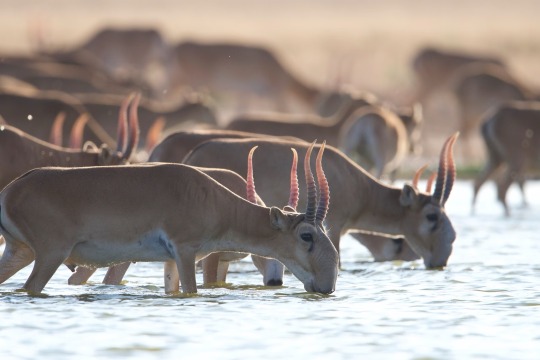
Saiga (Drinking on Southern Russia's Astrakhan Steppe) can migrate up to 600 miles over summer and winter. Photograph By Valeriy Malee/Nature Picture Library
#Animals 🦓 🦒 🐘#Floppy Nosed Antelope#Kazakhstan 🇰🇿 | Mongolia 🇲🇳 | Russia 🇷🇺 | Uzbekistan 🇺🇿#University of Oxford#Saiga Antelope#China 🇨🇳 | Singapore 🇸🇬 | Vietnam 🇻🇳 | Malaysia 🇲🇾#E.J. Milner-Gulland | Conservation Scientist | University of Oxford
44 notes
·
View notes
Note
Multi-question! You can respond to one or all of them!
What is your favorite Jhariah song?
What is your favorite Chonny Jash song?
What is your favorite OC?
Your favorite character or media (at the moment)?
If you could make an animatic or animation of anything you wanted right this minute, what would it be?
If you could learn any skill or hobby at the moment, what would you pick to learn?
OHOHOOOOHHHH HOORAAAAAY
1. either re:concerns or bad luck BUT I LOVE RE:CONCERNS ,,, ppaaaarassiiiittteee *i am shot to death before i csn continue singing
2. thats a Toughie. oooorgh. .. .either storm and a spring or count eleven. or dont take it personally I <3 DONT5KKAOEITPEROSNAALUL yeah its dtip fuck the othars IM ATTACHED TO COUNT ELEV EN THOGUGH
3. How Dare You Make Me Choose (its bliss)
4. ANIMATIC BATTLE!!!! I LLVVOOOOLLVV4VVRE DOORSTOPPER AND RAID AND EYEPATCH SO MUCH
5. probably an amv with fatewriter to saint bernard with a sillious red color pallette
6. uhh idk uhmmm . sigmaness Go my ungulates 🐐🐏🐖🐖🐏🐐🐄🐷🐄🐐🐪🐪🐫🦌🦌🦌🫏🐄🐐🦙🦙🐎🦌🐪🐑🐄🐏🐑🐄🦌🐎🫏🦙🐏🐖🐐🐐🐏🫏🐎🦌🦙🐐🦙🐑🐏🐎🦌🫏🦌🐎🐑🦙🐏🦒🦌🐎🦓🦙
4 notes
·
View notes
Text

The grasslands of South America are another biome quite different from today’s Pampas and Cerrado. With the warming climate, after an initial desertification of both grasslands and rainforest, both of the biomes bounced back, with the Amazon rainforest reaching as far south as Sucre in Bolivia, and the Pampas and Chaco reaching as far south as the Chubut province in Argentina.
Thanks to the Great American biotic interchange most of the continent’s fauna were already coming from an extinction event, and were already prepared for it, with most of the losses being ungulates.
Even though the extinction wasn’t such a hard hit on South America, it allowed for rapid diversification, with adaptations unseen in the rest of the world.
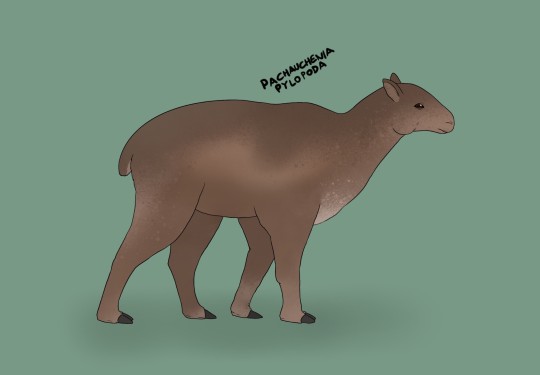
The biggest land animals in the continent are the Pachaucheninae, a lineage of vicuñas that came down from the Andes, and helped by their multi-chambered stomachs became the dominant graviportal herbivores.

Resembling their relatives in Eurasia and North America, maras here grew bigger, but still have a quite similar behaviour and diet to their modern-day ancestors. Still living in relatively small groups and forming monogamous couples, although with a significant difference: these mara herds have a shepherd, the lobo pastor (Lycalodromeus elaphugion). These maned wolves descendants, already mostly herbivorous, further went down this path, developing a taste for the soft and more easily digestible short grasses that the mara herds uncovered.
Being some of the most solitary canids they couldn’t hide into groups of their own kind, and already being dependant on mara herds, they started hanging around the edges of these herds, before getting incorporated into them and acting both as a deterrent for smaller predators and as a sentinel. Other than protection they also exploit the herds for food, eating the members that died and keeping at bay other scavengers much more dangerous for the herd, like South American foxes or vultures and condors, and in periods of famine snatching newborn rodents while the parents are sleeping. Most species of lobo pastor (Hyppolupinae) specialize in just one or two species of mara, coevolving and diversifying with them.
Other prevalently herbivorous generalists include the Vampire peccaries (Smilosuinae) and the Hyocyons, hog-like coatis, and the howling baboons (Hesperopapioninae), much less violent than their African cousins, with smaller jaws, not used as much for intrasexual competition, and less sexually dimorphic, with only a difference in size of 10-20% between the two sexes, but with substantial differences in colour, with males being very dark in colour with a black mane, and females being more cream coloured. They live in mixed sex groups but they’re still polygamous, retaining their ancestral group structure.
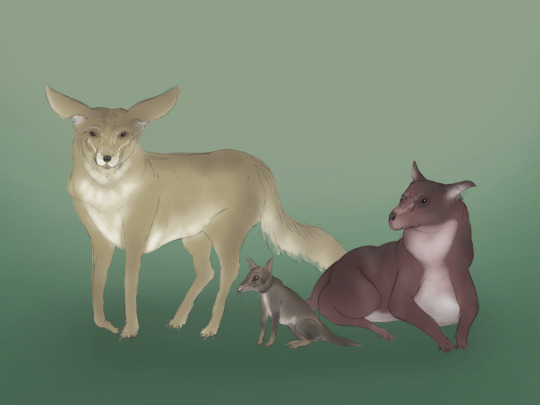
(foxes' art done by u/C4ss1m1r0 on reddit check him out)
Other critters wandering through the Pampas, Chaco and Cerrado are the giant tamanduas (Metamandua tetradactyla) descended from the southern tamandua, converging on the same overall body plan of the extinct giant anteater; and the extremely numerous South American foxes, such as Proceravulpes magnauris, a savannah-dwelling generalist; Canimurangustus tenebris, a small nocturnal fox endemic to the Caatinga; and Magnoripervinus caudabrevis, an omnivore that lives between the grasslands and Atlantic forests.
On top of the food chain are two Notopardus species: the Leão gaúcho, or León de las Pampas (Notopardus tiberius), a big felid, the biggest in the whole continent, that hunts in small packs, composed of a monogamous breeding pair and sometimes their cubs; and the Jaguarote (Notopardus panamericanus) that sometimes during the summer gets into the wetter parts of the grasslands.
#spec evo#spec bio#speculative evolution#speculative biology#worldbuilding#artwork#digital art#epigene period#future earth#future evolution
15 notes
·
View notes
Text

𝐈𝐍𝐓𝐑𝐎 -
— mae - 7teen - fart machine
𖦹 animal enthusiast
𖦹 sleepyhead
𖦹 adhd & social anxiety
𖦹 riot grrrl & punk enthusiast
( i do not dress like it 😭 )

𖦹 i fw w ungulates majorly
𖦹 and dinosaurs + other prehistoric reptiles
( pteradons are NOT dinos & i will die on that hill )
𖦹 fishing, hunting, outdoorsy sht & the works
𖦹 camping & being a camp counselor are my fav things to do in the summer
𖦹 i do nothing in the winter. f the winter man. winter more like seasonal depression wtf man
𖦹 artist, mainly digital
( never ever ever under any circumstances put
my art into any ai bs && never repost or use w/o
my permission pls & thank u luv u bye )
𖦹 multi fandoms
( fallout , rdr2 , arcane , starfield , mcsm , camp
camp , inside job , subnautica + below zero )
𖦹 fart jokes are funny. i am immature when it comes to humor. I am the funniest person alive yesyes
𖦹 favs ; deacon (fo4) , arthur morgan, charles smith, danse (fo4) , veektor (yk who I don’t even need to specify 😭) , jinx , sam coe , jesse (mcsm) , david (campcamp) brett hand
𖦹 music ; johnny cash , kimya dawson & moldy peaches , bikini kill , adrianne lenker , marty robbins , tom petty , bon jovi , luke bryan , nirvana , tyler
𖦹 idc abt dnis generally but here are my absolutes
( proship, racist, sexist, absolute hater, and all
that bunch can go crawl back into the hellhole
the clawed their way up from hell lmaoo )

𓆝 i have a wee bit of social anxiety but i love people and am always willing to talk :)) lets be moots ilu
— mae! 🫎🌲🔭
ps my insta is @ maediaries , i post my animal & whatnot collages on there :]]
1 note
·
View note
Text
More Secret TPOFATGIF Lore, Cryptids and Monsters Edition:
Long Post, the rest of it is Under The Cut:
Tristan isn't totally insane- the bites of a domestic dog, many types of Lycanthrope and Vampire, Selkie and Cupacabra are nearly identical without taking a cast and even then DNA Swab testing is often needed to diagnose what bit someone if they didn't get a good look at it.
While the majority of Lycanthropes* are humans with cyclic hybridism, Selkies are a rare instance of human-to-animal Zoonotic Curse transfer, where Cyclic Anthrothropy was transmitted to a population of harbor seals in the Outer Heberdies off Scotland around 1682. HOW the curse was transferred remains a mystery shrouded in some very unfortunate legends about "Seal Wives".
*Lycanthropy, of course, only refers to the most common from of Cyclic Hybridism, Canine Lunar Cyclic Hybridism or CLCH, also known as "Wolfman Disease". All known types of Cyclic Hybridism are not diseases, but variations of a blood-bourne curse that originated in Neolithic times, probably during Humanity's first attempts at controlling Magic. There are currently 486 documented types of Cyclic Hybridism, encompassing a total of 406 types of animals and 122 Cyclic schedules.
By Contrast, "Vampirism" refers to an entire group of Sanguivorious Human disorders with a wide variety of causes including, but not limited to: Viruses, Bacteria, hereditary curses, blood-bourne curses, prions, memetic fanaticism and even psychosomatic vampirism.
Vampires thus vary wildly in sensitivity to things like sunlight, running water, garlic, compulsive counting behaviors and being set on fire. Most types of Vampirism are contagious, particularly the infamous Sunnydale Syndrome which reached epidemic proportions from 1997-2001, but some are entirely idiosyncratic conditions or only hereditary.
The persistent rumor that bats carry vampirism is entirely inaccurate and the result of an early conflation of rabies with Vampiric disorders.
Chupacabra are a tragically endangered Keystone species and one of the few extant non-australian Marsupials. Their unsettling appearence and fondness for hunting livestock has made public outrach efforts difficult to say the least, but Chupacabra play a key role in preventing the spread of diseases in ungulates and the over-grazing of their native desert steppe.
Chupacabra originally evolved to hunt camelids and it's extreme speed and fearlessness when it came to hunting large prey on steep cliffs made it an important predator of wild Llama and Vicuna prior to the introduction of sheep and goats. Compared to an adult Llama, a goat is easy pickings, and it's hardly a suprise Chupacabra would start hunting this much slower, less aggressive prey, even at the risk of death by human shepherds.
Like thier closest living relatives, the Virginia Possum, the Chupacabra is relatively immune to rabies, has a total of 50 teeth and 13 nipples!
After decades of elusive behavior and difficulty in getting adequate samples, in 1996, Scientists were finally able to confirm that Mothmen have a complex, multi-generational migratory cycle, and that their primary egg-laying grounds are in the central valley of Nihofornia. Fresno Nightcrawlers are in fact, laval Mothmen. The discovery led to massive public adoration of the former omen of doom and improved conservation efforts, and now Mothmen numbers have rebounded and they occupy nearly all of their native range.
McElroy Monument near Huntington, West Virginia is home to an unusual Albino Mothman, lovingly named Indrid Cold. Misunderstanding the origins of his name and thinking Indrid to be chilly, visitors have tried gifting him sweaters in the past, which the Park Service now has to actively prevent, as Indrid has definitely eaten far too many of them.
Conservation efforts for Bigfoots, Yasha Ape and Sasquatch are also widely supported, with massive national parks devoted to thier preservation, but poaching for the illegal Big Toe Market (some people believe that the toes are a potent aphrodisiac) has seriously hindered efforts to build stable breeding troops of these species of Mega Ape.
There is an expiriemental program in Mt. Yasha National Park to assign 24/7 live-in human guards to the small troop there. So far the program has been sucessful as both sepcies protection and youth rehabilitation, as the Yasha Apes are particularly enamored of thier former-streetfighter-turned-mobile-zookeeper, Baki Hanma.
The Baja Basilisk, or "Loot Lizard" is no relative of the European Basilisk, but the confusion is understandable. More Accurately called the Behir, the Baja Basilisk is a massive reptile resembling an elongagted water monitor with up to 12 legs (they grow more as they age- one particularly ancient specimen was documented with a total of 16 legs) that is big enough to swallow a human whole. And swallow they do! The Loot Lizard earned it's nickname from its voracious appetite, indiscriminate palette and inability to chew, leading to Behir eating any vaugely animal-shaped object around them and horking up the indegestible pieces later.
Ambitious Adventurers have intermittently had sucess taming wild Behir- they make excellent mounts in enclosed spaces and any suspicious locked chest or ichor-covered idol can be tossed down the gullet of a tame Behir to be cleaned by it's powerful stomach, or digested if it happens to be a mimic, and the resalable parts regurgitated later.
Unfortunately, the popularity of Dungeon-crawling adventuring in the late middle ages, and the lack of knowledge about the Behir's long reproductive cycle (a Behir doesn't reach sexual maturity until age 60-80 at the earliest and may only produce two or three clutches of one or two eggs in it's life) lead to extensive poaching of Behir and the devastation of thier populations, and now they are only rarely found in a tiny sliver of thier previous rang, in the Baja Peninsula.
Tristan was very enamored of Behir in his youth and always wanted a pet one, much like how I wanted a Pet Tiger when I was six. His mom did make him a body-pillow size Behir Plushie and "Beans" still lives on his bed at home.
#TPOFATGIF#The Power Of Friendship (And This Gun I Found!)#yugioh#fanfic#werewolf#vampire#mothman#chupacabra#selkie#Basilisk#Sasquatch
284 notes
·
View notes
Text

Siberian maral Cervus canadensis sibiricus, left and center
Siberian roe deer Capreolus pygargus pygargus, right
Observed by andreenkov, CC BY-NC
#multi-ungulate#Cervus canadensis sibiricus#Siberian maral#Capreolus pygargus pygargus#Siberian roe deer#Cervidae#deer#Asia#Russia#Altai
107 notes
·
View notes
Text
As for all the people wanting to actually know if reindeer get laminitis... tl;dr in this situation not really...
Reindeer are ruminants/foregut fermenters, like cows, sheep, and goats, not hindgut fermenters like horses. That means they have a multi-compartment stomach where they ferment food before it goes to the intestine. In ruminants, high carb/sugar diets has a more acute problem -- rumen acidosis (the stomach microbiology for fermentation get thrown out of wack and ends up acidifying the blood).
Dietary laminitis like that in question in horses is because of improper metabolism of sugars. While laminitis does occur in ruminant ungulates (especially dairy cattle), and thus reindeer probably can get laminitis, a spike in sugar intake would have much more pressing issues...
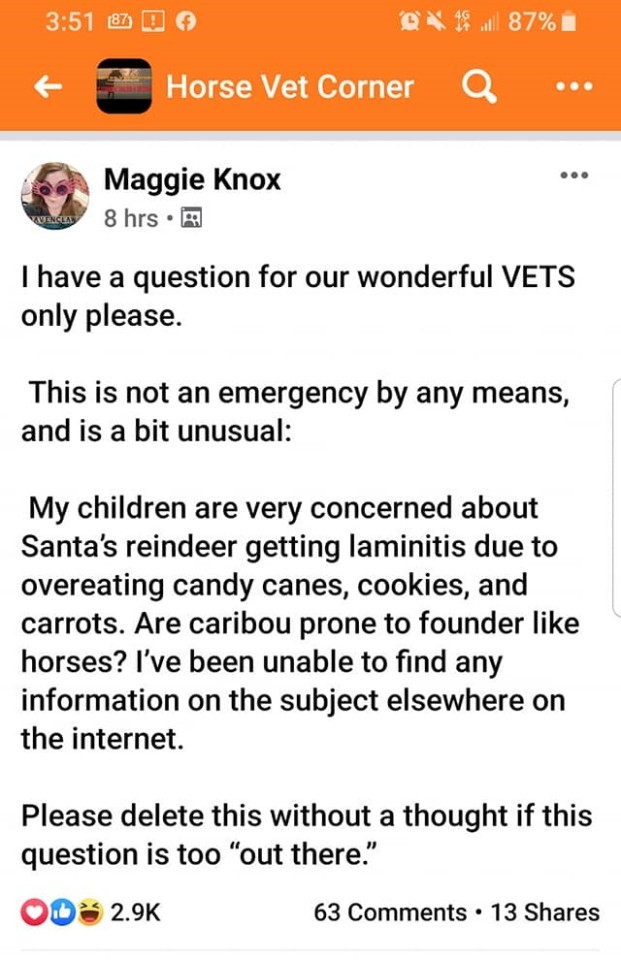
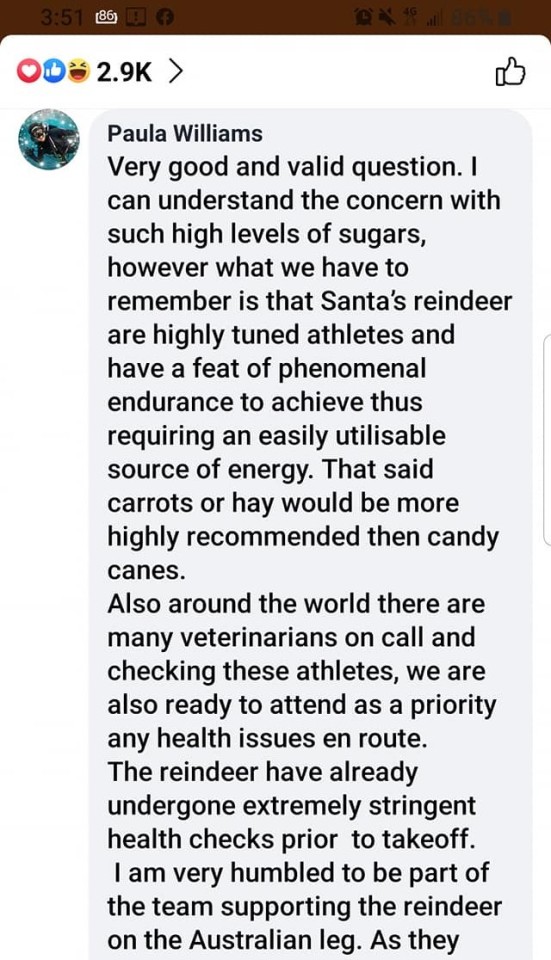

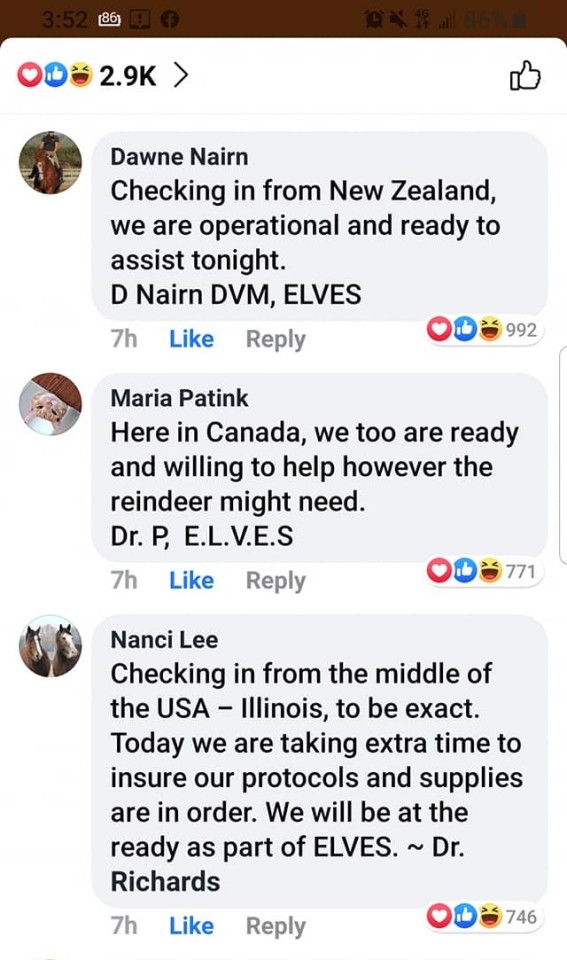
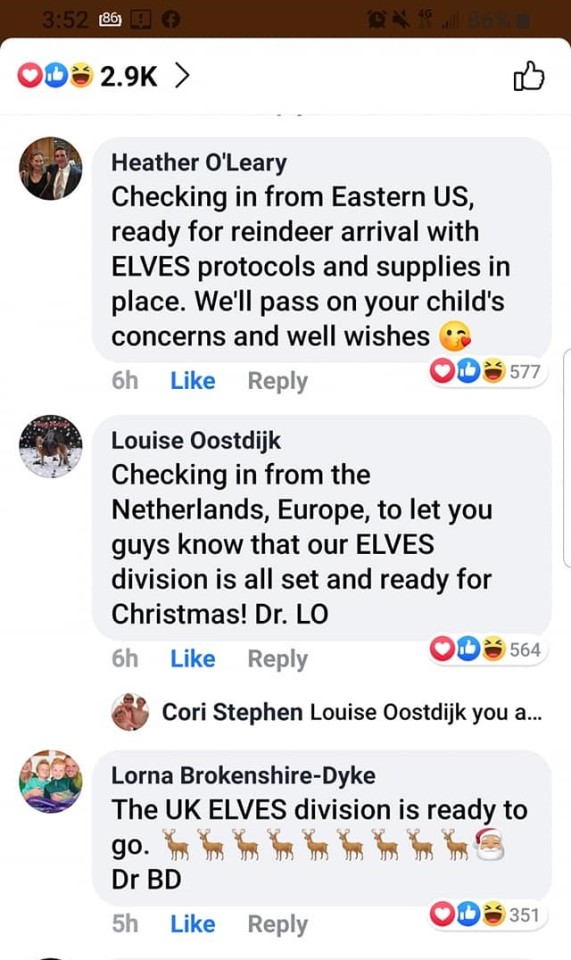
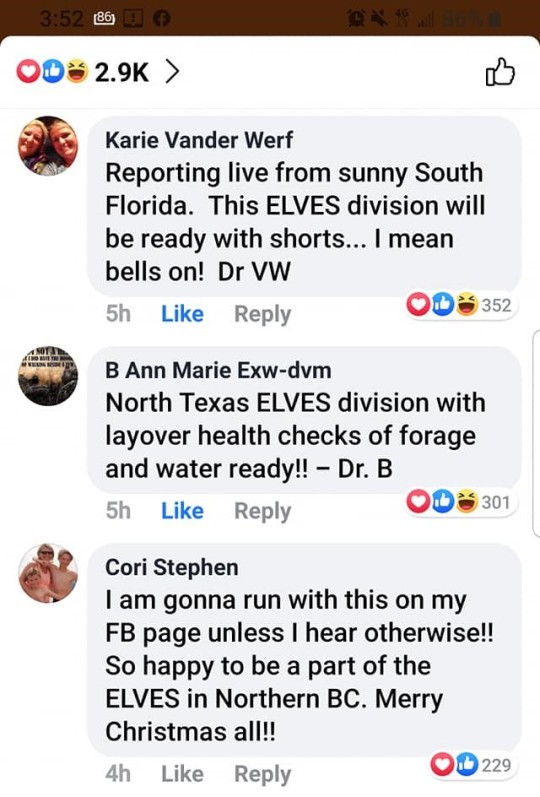


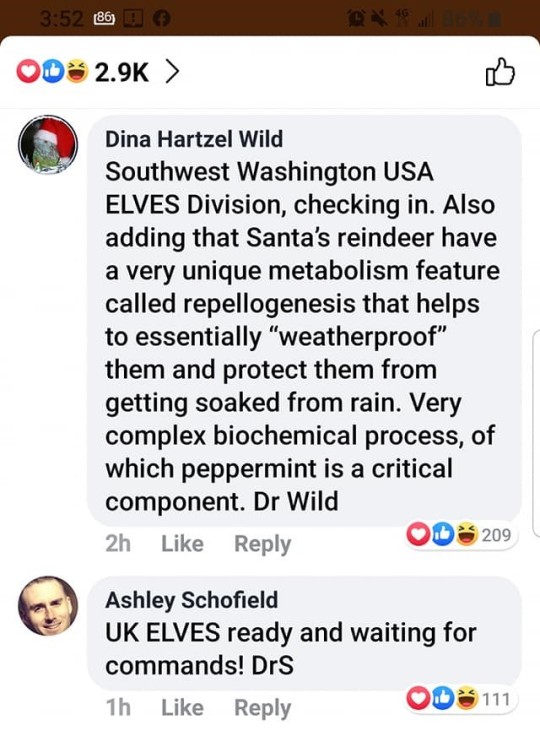
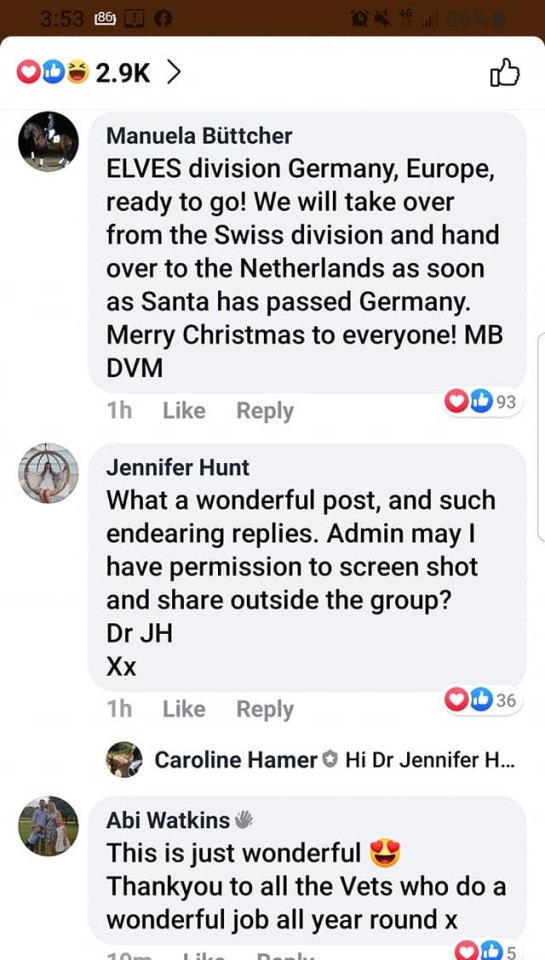

Santa's Reindeer will be well taken care of tonight 😉🦌🎅🏼🎄
#one of the replies is my prof#i can go harass her if u want a dvm answer jkjk#laminitis#or laminopathy as one of the pathologists would have us say#also#is lameness really such a problem given the hypothetical santa reindeer can fly
26K notes
·
View notes
Photo


Another one of my Spore creatures done! Yay!
Some sort of... Omnivorous rocky multi-eyed bovine... I really love ungulates, but man are their legs hard to draw. Especially from the front!
Here’s this guy in-game:

#creature design#spore#spore oc#ea games#maxis#drawing#digital art#twecktart#not that... these legs are particularly accurate to bovines anyway.
83 notes
·
View notes
Note
The horse (Equus ferus caballus)[2][3] is one of two extant subspecies of Equus ferus. It is an odd-toed ungulate mammal belonging to the taxonomic family Equidae. The horse has evolved over the past 45 to 55 million years from a small multi-toed creature, Eohippus, into the large, single-toed animal of today. Humans began domesticating horses around 4000 BC, and their domestication is believed to have been widespread by 3000 BC. Horses in the subspecies caballus are domesticated, although some

...How long did it take to write this?
24 notes
·
View notes
Note
how the fuck are the naturally glowing fish, godzilla sized aquatic ungulates, bug that punches so fast that it creates a miniature explosion, blob that can reverse its age, multi-limbed creatures with shapeshifting and near human intelligence, and fucking siphonophores boring
The ocean is boring and basic and unsexy and so is everything that comes from it sorry you’re so wrong ig
FUCK YOUFUCIYOU FUCK YOUR UCK YOU FUCK YOU FUCK UPUF FUCK YOU FUCKCUL YOU FUCK YOU FUCK FUOU YOU THE OCEAN IS SO FULL OF LIFE AND BEAUTY AND SHE GIVES US SO MUCH AND SHE CAN KICKYOUR ASS
25 notes
·
View notes
Note
The cat (Felis catus) is a domestic species of small carnivorous mammal.[1][2] It is the only domesticated species in the family Felidae and is often referred to as the domestic cat to distinguish it from the wild members of the family.[4] A cat can either be a house cat, a farm cat or a feral cat; the latter ranges freely and avoids human contact.[5] Domestic cats are valued by humans for companionship and their ability to hunt rodents. About 60 cat breeds are recognized by various cat registries.[6]
Anonymous said: Sheep (Ovis aries) are quadrupedal, ruminant mammals typically kept as livestock. Like all ruminants, sheep are members of the order Artiodactyla, the even-toed ungulates. Although the name sheep applies to many species in the genus Ovis, in everyday usage it almost always refers to Ovis aries. Numbering a little over one billion, domestic sheep are also the most numerous species of sheep. An adult female is referred to as a ewe (/juː/), an intact male as a ram, occasionally a tup, a castrated male as a wether, and a young sheep as a lamb.
Anonymous said: The horse (Equus ferus caballus)[2][3] is a domesticated odd-toed ungulate mammal. It belongs to the taxonomic family Equidae and is one of two extant subspecies of Equus ferus. The horse has evolved over the past 45 to 55 million years from a small multi-toed creature, Eohippus, into the large, single-toed animal of today. Humans began domesticating horses around 4000 BC, and their domestication is believed to have been widespread by 3000 BC. Horses in the subspecies caballus are domesticated, although some domesticated populations live in the wild as feral horses. These feral populations are not true wild horses, as this term is used to describe horses that have never been domesticated, such as the endangered Przewalski's horse, a separate subspecies, and the only remaining true wild horse. There is an extensive, specialized vocabulary used to describe equine-related concepts, covering everything from anatomy to life stages, size, colors, markings, breeds, locomotion, and behavior.
Anonymous said: Whales are a widely distributed and diverse group of fully aquatic placental marine mammals. They are an informal grouping within the infraorder Cetacea, usually excluding dolphins and porpoises. Whales, dolphins and porpoises belong to the order Cetartiodactyla, which consists of even-toed ungulates. Their closest living relatives are the hippopotamuses, having diverged about 40 million years ago. The two parvorders of whales, baleen whales (Mysticeti) and toothed whales (Odontoceti), are thought to have split apart around 34 million years ago. Whales consist of eight extant families: Balaenopteridae (the rorquals), Balaenidae (right whales), Cetotheriidae (the pygmy right whale), Eschrichtiidae (the grey whale), Monodontidae (belugas and narwhals), Physeteridae (the sperm whale), Kogiidae (the dwarf and pygmy sperm whale), and Ziphiidae (the beaked whales).
Anonymous said: The kangaroo is a marsupial from the family Macropodidae (macropods, meaning "large foot"). In common use the term is used to describe the largest species from this family, the red kangaroo, as well as the antilopine kangaroo, eastern grey kangaroo, and western grey kangaroo.[1] Kangaroos are indigenous to Australia and New Guinea. The Australian government estimates that 34.3 million kangaroos lived within the commercial harvest areas of Australia in 2011, up from 25.1 million one year earlier.[2]
Anonymous said: Otters are carnivorous mammals in the subfamily Lutrinae. The 13 extant otter species are all semiaquatic, aquatic or marine, with diets based on fish and invertebrates. Lutrinae is a branch of the Mustelidae family, which also includes weasels, badgers, mink, and wolverines, among other animals.
Anonymous said: Duck is the common name for numerous species in the waterfowl family Anatidae which also includes swans and geese. Ducks are divided among several subfamilies in the family Anatidae; they do not represent a monophyletic group (the group of all descendants of a single common ancestral species) but a form taxon, since swans and geese are not considered ducks. Ducks are mostly aquatic birds, mostly smaller than the swans and geese, and may be found in both fresh water and sea water.
Anonymous said: The platypus (Ornithorhynchus anatinus), sometimes referred to as the duck-billed platypus, is a semiaquatic, egg-laying mammal endemic to eastern Australia, including Tasmania. The platypus is the sole living representative of its family (Ornithorhynchidae) and genus (Ornithorhynchus), though a number of related species appear in the fossil record.
Anonymous said:hope you enjoyed my animal facts 😌
HELPPPEKDFJNJIKMNFBVJKKDFJHUIJRKFNHIFJ
3 notes
·
View notes
Text
LoL Chapter 8- Power Surge
Masterpost
A Wizard Hermits tale (AU belongs to @theguardiansofredland )
Team ZIT- and Mumbo- are left behind to handle the dark crystal. When even Tango's hellbound magic and Impulse's explosion magic don't seem to work, can Mumbo get his own magic to even appear and help his friends?
--------------------------
Tango and Zedaph were eventually kicked out of the infirmary, among other hermits. Now, only Cleo, Grian, Xisuma, Ren, and Wels are in the building. Hermits settle back into their homes, but four stare at the blue orb sitting in the grass.
“It looks so innocent, tucked away in Jev’s slime.” Mumbo whispers, afraid to step closer.
“Like it didn’t just attack and nearly drain almost all of TFC’s magic and life.” Tango growls, teeth baring as he stares at the dangerous item. He works with dangerous magic, hellbound spells. But this isn’t like that. Hellbound magic takes power from the underworld. This takes power from other creatures. Living creatures, life sustaining magic stolen from their bodies. Sucking it up like it did TFC. And Gildara.
“We need to take care of it.” Impulse rises from his crouch, an easy smile on his face as he cracks his knuckles. “Let’s get this thing out of our hair.”
Impulse flicks his hands, shocking yellow magic appearing in the air. He pulses the magic forward, and a concussive blast ripples from his hands. The ground blossoms red and orange, dirt tossed across the group remaining on the train grounds.
But when the dust settles, the crystal is nestled in the crater Impulse blew apart. Slime had been eviscerated, only the black rock left behind. He tries another explosion, focused and sharp. Still nothing. Impulse sighs, knowing he needs help. “Tango, can you perhaps lend a hand, man?”
Tango grins, cracking his knuckles and joining Impulse in the fight to break the gem. Leaving Zedaph with Mumbo. “Alright, I’ll put it to fire and you blow it to pieces. I got your back.”
The two share a fistbump, and activate their respective magic in tandem. Tango’s pattern curls and pops red like a fire, while Impulse explodes yellow outward, shockwaves and blasts in his circle. Two impish smiles and fiery eyes look down at the tiny crystal.
And they don’t hold back. A wall of fire, so hot it turns blue, burning at the gem and it’s dirt surroundings. Warping the stone and dirt it nests within. Zed and Mumbo find themselves flung backwards by Impulse’s blast, their heads spinning and teeth rattling. Impulse and Tango managed to stay upright, hair sweeping back and feet dug into grass in an attempt to not meet a similar fate as their friends. Tango sees it first. “This stupid fucking gem won’t break!”
Fire erupts around Tango, but he’s quick to tamper down any of his frustration, aided by his friends. Impulse and Zedaph join him, glaring at the crystal as they plot on how to destroy it. They don’t just want to break it- they want to obliterate it. The crystal siphoned energy from TFC, attacking him when he used it. Zedaph closes his eyes, grimacing as he remembers the black veins and pale skin that marred their guildmaster. His soft purple irises remain closed as Tango and Impulse continue.
“Maybe we can borrow False’s cannon?” Tango whispers.
“I don’t think she’ll give us that ever again.” Impulse looks over his shoulder, seeing the dark oak and stone brick home, the forge nestled in the crook of the house. A part of the roof is new wood, but Tango and Impulse have still yet to fix the other hole in the back of the house.
Zedaph opens his eyes, and sees Mumbo. Standing a distance away, shifting from foot to foot and watching the grass at his feet sway in the sea wind. Awkward and alone. “Hey Mumbo. You have lightning magic, right?”
The multi-mage jumps back into reality, patting his foot over the indent he dug with his boots and tugging on the seam of his sleeve. “Oh, y-yeah. Not well, per se, but I have lightning magic.”
“Maybe we can be a little cleverer- more clever? I dunno, whichever- about evicting this gem from existence.” Zedaph smooths his hair, nodding Mumbo to join the trio. “I’m not exactly the crystal guy, but gems tend to have a lattice structure to it, yeah?”
“That’s what they taught us in middle school.” Tango chuckles. He tucks one hand under his forearm, still feeling the exciting energy of casting his magic. Hellbound magic was unstable, changing on a whim and easy to lose control. Not just of the magic, but of oneself. He spent years just training to keep himself in check, making sure he never falls victim to the nature of magic. Admit it’s danger, but find beauty in it, in the same way Zedaph sees a soul to shepard in even the most rabid animal, and Impulse can refine any explosion into art like a flower.
“Well, if Mumbo can excite the lattice of the crystal, it will be less stable. You two can go at it with the booming and blazing, and bam! No more creepy gem wanting to take over our grandpa.” Zedaph rests his hands on his waist, looking around at the others.
Impulse and Tango are all in. Among the ZIT trio, Zedaph is the one with the craziest plans. The ones that always somehow end up working. But Mumbo isn’t so convinced. “You guys are placing a lot of faith on me and my magic. I don’t know if I’ll be able to control it like you want. I can hardly even summon it.”
Just to prove his point, Mumbo opens his hands. A wobbly red circle casts in each palm, before falling apart. Mumbo’s shoulders drop, and even the tips of his robes collars seem to wilt with his emotions.
“Come on, Mumbo. We’ve seen your power- you’ve got more than most of us combined. You’re a multi-mage, that’s so cool man!” Impulse’s cheerful excitement exudes off him like sunshine, rippling out like an explosion’s heat. And just as energetic.
“You’ve been training with Grian and Iskall, and when you really put your mind to it, you destroyificate them.” Tango adds, grinning as he remembers seeing those two cocky hermits get blown off their feet by the newbie. “That’s not one but two S-Class wizards you can easily hold off. This wimpy little crystal should be trembling in it’s cleavage.” Zedaph and Impulse can’t help but giggle at the word. Still immature adults.
“Bu-but I can’t control when that happens. We haven’t figured out how to yet.” When he’s not training with Grian and Iskall, he’s digging through Joe’s library and talking with Xisuma. So much power, it takes so much to call upon, to release. It’s like breaking open a dam, and the power rushes out of him when he does. If he’s not careful, it can take control of him, instead of the other way around.
“Just give it a shot. You never know until you try!” Zedaph pushes Mumbo in front of Tango and Impulse, and retreats. His magic isn’t exactly useful in this situation.
Mumbo’s quaking in his boots. “Oh, oh dear. Well, I guess I’ll just-” He raises his hand, fingers shaking as he draws up his sigil. A blossoming red lotus of redstone and electricity, flecks of magic falling away like embers. They drift into the sky, carried up towards the bright blue atmosphere and fluffy white clouds. Zedaph can’t help but notice that they look like sheep, his ungulate allies in the barn he calls home.
When he looks back down, the circle has been cast. But what the trio sees erupt from Mumbo’s hand looks less like a great bolt of red lightning, and more like a static shock stained ruddy. Mumbo whimpers, watching it disappear like the embers of his circle. He doesn’t have the courage to tell the trio he told them so, because he’s so focused on his own failure.
“Aww, it’s okay Mumbo. Just try again- I’m sure you can do it.” Zedaph, dares to step forward, giving a hearty pat on Mumbo’s back. Zedaph grew up in the rural countryside around Foresta, where everything is rough. Calloused hands from years of farming give the tightest hugs.
And a weak city boy like Mumbo just wasn’t prepared for Zed’s strength. There was no malice, but his lanky body just couldn’t handle the slap on the back. He stumbles forward, hands catching himself on the ground- and sparking the magic deep within him. Magic flows freely from his fingers, redstone forming a circuit along the verdant grass and into the crater Impulse has created. Magic rushes through him, overwhelming each and every atom and fiber of his being. He doesn’t have control of his magic. His magic has control of him.
The circuit connects to the gemstone, the dust illuminating and lightning ricocheting free from the trail. Mumbo blinks, his eyes filling with red light as magic takes over his whole body. So much magic, uncontained by a circle.
“Guys, do it now!” Zedaph orders, noting the way the dark crystal rocks in the dirt. It glows from within, red light and lightning escaping the darkness of the opaque gem. Being ripped apart by Mumbo’s astounding magic. Zed knew Mumbo was strong- but this? This is unlike anything he’s ever seen. Including two different forms of magic.
Impulse doesn’t waste a second. He waves his hand, casting a spell and snapping his fingers. The crater grows deeper as the dirt erupts in an explosion, smoke illuminated by deep red and yellow fire from Tango’s magic. They don’t stop, they don’t let up. Only when the dust settles and smoke clears away, Mumbo’s circuit going dead, does Zedaph dare to peek into the cavity caused by his friends.
The crystal has been obliterated. All that’s left it dust, caught by the wind and scattered into the azure waves of the sea around them. Team ZIT celebrates the defeat of the crystal, grabbing one another and pouncing on their backs. Howling with joy and rubbing their knuckles rough into each other’s hair and back. Mumbo stands up silently, bolts of lightning escaping from his hands. Striking around him, turning the grass a burnt black color. And growing stronger.
“We did it, guys! We showed that stupid crystal it messed with the wrong guild!” Impulse cheers, his smile so wide across his face it hurts his cheek.
“Mumbo, dude, that was incredible.” Tango looks over Zedaph’s shoulder, brushing dirt off of the pink capelet. Mumbo doesn’t answer Tango’s compliment. He’s just standing in the grass, eyes closed. Zaps of lightning grow more frequent each second. “Mumbo?”
Zedaph steps away, pulling free of Impulse and Tango’s touch. He reels back as a bolt of lightning nearly hits his leg, all his blond hair standing on end. “Mumbo? Mumbo can you hear us?”
Mumbo’s eyes snap open. But those grey irises, filled with inquisitivity and anxiety, are overshadowed by a glowing red. Sparks like static electricity crease free from his eyes, staring blindly out. Mumbo’s not in control of his magic. Impulse is the first to notice his feet losing connection with the ground. “He’s going into a power surge!”
Impulse and Tango run into the lightning storm, each grabbing a sleeve of Mumbo’s black robe. Holding him down, their faces creased with pain when lightning courses into their body. They can feel the air turn to ozone, the scent of a storm on the horizon. Tango clenches his teeth, digging his heels into the ground. They shouldn’t have pushed Mumbo when he wasn’t ready. He needs to have control of his magic. “Zedaph! Do something!”
Zedaph is already summoning his magic circle, the intricate spell requiring a number of motions to draw it up. Taking control of an animal is one thing. A human is something completely different. And a friend, more than anything. He hates having to remove their free will- but Mumbo isn’t in control. He has to do something. Impulse slips from his grip on Mumbo’s sleeve, fingers digging into the gold trim near the newest guildmember’s ankles. The grass is becoming further from Mumbo’s feet, weightless like a feather.
“Mumbo!” Zed calls as he casts his spell. The two souls find a connection, Zedaph pulling on Mumbo’s soul. Trying to bring sense back from the senseless entropy of magic. Zedaph is standing still, but his face is contorted as he works to calm his friend down. He’s a shepherd mage, this is his job. To herd minds in the direction he so pleases. Animals, humans, he has the ability to speak to things beyond human language. To people beyond talk. To Mumbo, trapped and warped in his own magic. “Mumbo, calm down. Take control again.”
Zedaph’s voice was no louder than a whisper, but to Mumbo it was a roar. His eyes blink away the red that blinded him, falling back to the ground with a stumble. His mind feels hazy, his body two steps ahead of his actual consciousness. Grass brushes against his hands, a gentle tickle against tingling skin. He finally looks up, and finds he’s not the only one on his knees. Zed has fallen down, his face pale but still smiling.
Mumbo struggles to stand, struggles to understand what happened. Until he hears a crunch at his feet. He looks down, moving his boot out of the way. The blades of verdant green have been charred black, rocks and dirt flung aside. Like lightning struck the ground. “Oh, oh dear.”
“It’s okay, Mumbo.” Zedaph whispers, wiping blood from his nose. “We got the job done, and that’s what matters. Good work, destroying the crystal. I knew you could do it.” His smile does little to ease Mumbo’s concerns.
#hermitcraft#light of lairyon#lol#hermitblr#wizard au#wizard hermits#wizard tango#wizard impulse#wizard zedaph#wizard mumbo#team zit#tangotek#impulsesv#zedaph#mumbo jumbo#hermitcraft fic#hermitcraft au
29 notes
·
View notes
Text
Pekrem, the Arid Grazer

Image credit @ Sevireeno Deeno
Sight ●●○○○
Hearing ●●●○○
Smell ●●●○○
Strength ●●●○○
Speed ●●●○○
Intelligence ●○○○○
BASIC INFO
Classification:
Even-Toed Ungulate (Artiodactyla)
Size:
Small
Diet:
Pekrem are grazing herbivores that eat mainly grasses, roots, and low-lying shrubs. Their strong jaws, and multi-chambered stomach, allow them to process hardy plant material that other grazers wouldn’t be able to eat.
Habitat:
Pekrem are mainly found in low-lying, dry climates and biomes — such as savannas, deserts, and other arid landscapes.
Social:
Pekrem are herd animals that travel in groups of roughly 5 - 10.
DETAILED INFO
Predator / Prey Relationship:
Pekrem do not eat meat, but are one of the primary food sources for predators in their environment. Since pekrem reproduce quickly, and lack many natural weapons, predators often find them an easy snack. Pekrem are, however, fairly quick and can do quite a bit of damage when they are in a group.
Appearance:
Pekrem look like large rodents about the size of a dog, although they have hooves similar to a small deer. They have a large snout and buggy eyes of various colors and hues. The most common eye colors are green and blue. Pekrem have coarse, brown fur that covers their body, coming in different shades from tan to chestnut. Sometimes they are born with odd-colored markings on their bodies such as spots and stripes. The male pekrem is bulkier, and stockier, than his female counterpart, and also has a shorter tail. One of the distinguishing features of a pekrem is the hairy mane along their back and spine, which is usually a lighter color than the rest of their fur.
Relationship w/ Humans:
Pekrem and humans have had a mutually beneficial relationship for many years. As early as the first days of Kemet, people were raising pekrem as livestock. Sometimes they would paint them with odd colors, distinguishing them as property of particular families or tribes. It is also known that Kemetians used pekrem in their religious rites. Pekrem run wild throughout the arid environments of Aeora, particularly in the southern hemisphere; however, humans in many regions have used them as a source of meat and fur, and have hunted them so heavily that wild pekrem can only be found in a few places. Furthermore, pekrem meat has been a popular trade good across many nations.
Check out the original post
#fantasy#worldbuilding#fantasy writing#fantasy creature#original#Aeora#Prose#writing#Writeblr#creature#creature design
1 note
·
View note